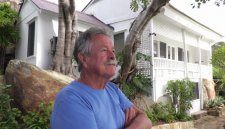Glenn Murcutt AO (b. 1936), architect, received the world's highest architectural honour when he was awarded the Pritzker Prize in April 2002. Having spent a good deal of his youth in New Guinea, where he learned to love simple shapes and materials, Murcutt only just scraped into a university architecture course at the University of New South Wales, graduating in 1961. As a student, he drew on principles he had learned while working for his father, who had a number of building businesses in Sydney after the war. Murcutt is unusual among Pritzker winners in that he works alone, mostly on residential homes; he has never made a skyscraper or a tourist attraction; and he uses mostly basic materials. By using shades, louvres, fully opening walls and carefully planned ventilation he enables his buildings to respond instantly to changing conditions and requirements. His overriding design philosophy is that dwellings should 'touch the earth lightly'. There are several books about his work, including Leaves of Iron (1991) and Touch This Earth Lightly (2000) by Philip Drew and Glenn Murcutt: Buildings + Projects 1962–2003 (2003) by Françoise Fromonot. Murcutt's Islamic Centre project, an unconventional mosque in suburban Melbourne, is at the heart of an intimate film about Murcutt by Catherine Hunter, Glenn Murcutt: Spirit of Place (2016). He is a Professor at UNSW, and is the principle 'master' on the Architecture Foundation Australia annual International Architecture Master Classes.
Collection: National Portrait Gallery
Gift of Rosemary and Robert Walsh 2006
© Anthony Browell



On one level The Companion talks about the most famous and frontline Australians, but on another it tells us about ourselves.



Iconic Australian artist Ken Done discusses his life and career as a painter.



Award-winning Australian architect, Glenn Murcutt describes the philosophy of his architectural practice and his minimalist portrait by Ken Done.